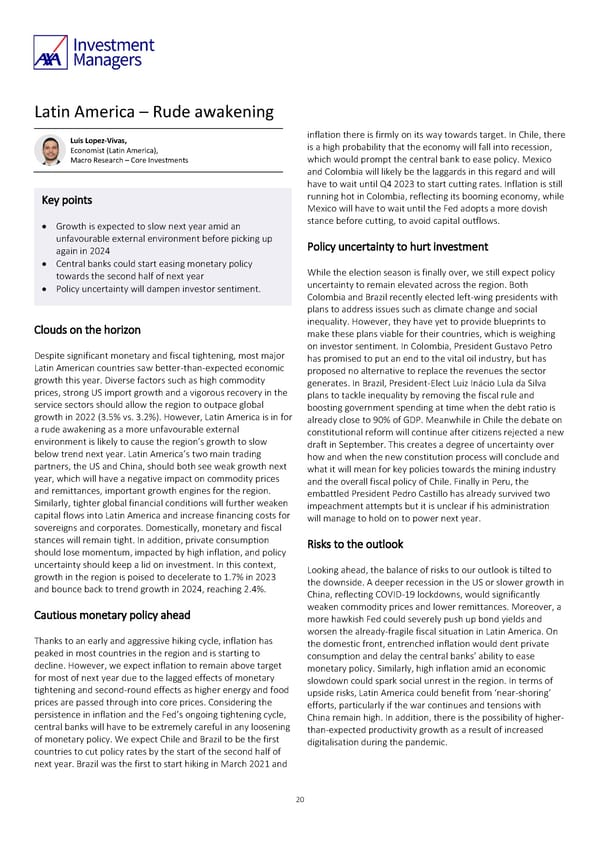Latin America – Rude awakening Luis Lopez-Vivas, inflation there is firmly on its way towards target. In Chile, there Economist (Latin America), is a high probability that the economy will fall into recession, Macro Research – Core Investments which would prompt the central bank to ease policy. Mexico and Colombia will likely be the laggards in this regard and will have to wait until Q4 2023 to start cutting rates. Inflation is still Key points running hot in Colombia, reflecting its booming economy, while Mexico will have to wait until the Fed adopts a more dovish • Growth is expected to slow next year amid an stance before cutting, to avoid capital outflows. unfavourable external environment before picking up again in 2024 Policy uncertainty to hurt investment • Central banks could start easing monetary policy towards the second half of next year While the election season is finally over, we still expect policy • Policy uncertainty will dampen investor sentiment. uncertainty to remain elevated across the region. Both Colombia and Brazil recently elected left-wing presidents with plans to address issues such as climate change and social Clouds on the horizon inequality. However, they have yet to provide blueprints to make these plans viable for their countries, which is weighing on investor sentiment. In Colombia, President Gustavo Petro Despite significant monetary and fiscal tightening, most major has promised to put an end to the vital oil industry, but has Latin American countries saw better-than-expected economic proposed no alternative to replace the revenues the sector growth this year. Diverse factors such as high commodity generates. In Brazil, President-Elect Luiz Inácio Lula da Silva prices, strong US import growth and a vigorous recovery in the plans to tackle inequality by removing the fiscal rule and service sectors should allow the region to outpace global boosting government spending at time when the debt ratio is growth in 2022 (3.5% vs. 3.2%). However, Latin America is in for already close to 90% of GDP. Meanwhile in Chile the debate on a rude awakening as a more unfavourable external constitutional reform will continue after citizens rejected a new environment is likely to cause the region’s growth to slow draft in September. This creates a degree of uncertainty over below trend next year. Latin America’s two main trading how and when the new constitution process will conclude and partners, the US and China, should both see weak growth next what it will mean for key policies towards the mining industry year, which will have a negative impact on commodity prices and the overall fiscal policy of Chile. Finally in Peru, the and remittances, important growth engines for the region. embattled President Pedro Castillo has already survived two Similarly, tighter global financial conditions will further weaken impeachment attempts but it is unclear if his administration capital flows into Latin America and increase financing costs for will manage to hold on to power next year. sovereigns and corporates. Domestically, monetary and fiscal stances will remain tight. In addition, private consumption Risks to the outlook should lose momentum, impacted by high inflation, and policy uncertainty should keep a lid on investment. In this context, Looking ahead, the balance of risks to our outlook is tilted to growth in the region is poised to decelerate to 1.7% in 2023 the downside. A deeper recession in the US or slower growth in and bounce back to trend growth in 2024, reaching 2.4%. China, reflecting COVID-19 lockdowns, would significantly weaken commodity prices and lower remittances. Moreover, a Cautious monetary policy ahead more hawkish Fed could severely push up bond yields and worsen the already-fragile fiscal situation in Latin America. On Thanks to an early and aggressive hiking cycle, inflation has the domestic front, entrenched inflation would dent private peaked in most countries in the region and is starting to decline. However, we expect inflation to remain above target consumption and delay the central banks’ ability to ease monetary policy. Similarly, high inflation amid an economic for most of next year due to the lagged effects of monetary slowdown could spark social unrest in the region. In terms of tightening and second-round effects as higher energy and food upside risks, Latin America could benefit from ‘near-shoring’ prices are passed through into core prices. Considering the efforts, particularly if the war continues and tensions with persistence in inflation and the Fed’s ongoing tightening cycle, China remain high. In addition, there is the possibility of higher- central banks will have to be extremely careful in any loosening than-expected productivity growth as a result of increased of monetary policy. We expect Chile and Brazil to be the first digitalisation during the pandemic. countries to cut policy rates by the start of the second half of next year. Brazil was the first to start hiking in March 2021 and 20
 AXA IM Outlook 2023 full report Page 19 Page 21
AXA IM Outlook 2023 full report Page 19 Page 21